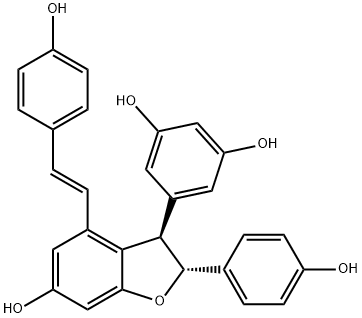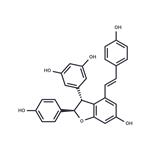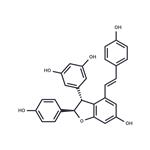trans-ε-Viniferin is a stilbene polyphenol and dimer of trans-resveratrol that has been found in various red wines and has diverse biological activities. It induces disaggregation of aggregated amyloid-β (1-42) (Aβ42; ) fibrils in a cell-free assay and decreases Aβ42- and IL-1β-induced release of TNF-α and IL-6 in primary mouse neuron and astrocyte cocultures. trans-ε-Viniferin reduces cytotoxicity induced by truncated huntingtin (Htt) in PC12 cells (EC50 = 30 nM). It also reduces production of reactive oxygen species (ROS), mitochondrial dysfunction, and PGC-1α depletion and increases protein levels and deacetylase activity of sirtuin 3 (SIRT3) in cells expressing mutant Htt. trans-ε-Viniferin inhibits calcium-activated chloride channel currents in HT-29 cells (IC50 = ~1 μM). In vivo, trans-ε-viniferin (2 μg per animal) reduces rotavirus-induced secretory diarrhea in mice without affecting the rotaviral infection. Dietary administration of trans-ε-viniferin reduces hepatic triglyceride accumulation and body weight increases in a mouse model of diet-induced obesity.
ε-Viniferin is a stilbene extract posessing cytotoxic effects and may contain anti-cancer properties.
ChEBI: (-)-trans-epsilon-viniferin is a stilbenoid that is the (-)-trans-stereoisomer of epsilon-viniferin, obtained by cyclodimerisation of trans-resveratrol. It has a role as a metabolite. It is a member of 1-benzofurans, a polyphenol and a stilbenoid. It is functionally related to a trans-resveratrol. It is an enantiomer of a (+)-trans-epsilon-viniferin.
5-HT Receptor | MAO | Antifection



